ACL Filters on Aironet APs Configuration Example
Available Languages
Contents
Introduction
This document describes how to configure Access Control List (ACL)-based filters on Cisco Aironet Access Points (APs) with use of the GUI.
Prerequisites
Requirements
Cisco recommends that you have basic knowledge of these topics:
- The configuration of a wireless connection with use of an Aironet AP and an Aironet 802.11 a/b/g Client Adapter
- ACLs
Components Used
This document uses Aironet 1040 Series APs that run Cisco IOS® software Release 15.2(2)JB.
The information in this document was created from the devices in a specific lab environment. All of the devices used in this document started with a cleared (default) configuration. If your network is live, make sure that you understand the potential impact of any command.
Background Information
You can use filters on APs in order to perform these tasks:
- Restrict access to the wireless LAN (WLAN) network
- Provide an additional layer of wireless security
You can use different types of filters in order to filter traffic based on:
- Specific protocols
- The MAC address of the client device
- The IP address of the client device
You can also enable filters in order to restrict traffic from users on the wired LAN. IP address and MAC address filters allow or disallow the forwarding of unicast and multicast packets that are sent to or from specific IP or MAC addresses.
Protocol-based filters provide a more granular way to restrict access to specific protocols through the Ethernet and radio interfaces of the AP. You can use either of these methods in order to configure the filters on the APs:
- Web GUI
- CLI
This document explains how to use ACLs in order to configure filters through the GUI.
Configure
This section describes how to configure ACL-based filters on Cisco Aironet APs with use of the GUI.
Where to Create ACLs
Navigate to Security > Advance Security. Choose the Association Access List tab, and click Define Filter:


MAC Address Filters
You can use MAC address-based filters in order to filter client devices based on the hard-coded MAC address. When a client is denied access through a MAC-based filter, the client cannot associate with the AP. MAC address filters allow or disallow the forwarding of unicast and multicast packets either sent from, or addressed to, specific MAC addresses.
This example illustrates how to configure a MAC-based filter through the GUI in order to filter the client with a MAC address of 0040.96a5.b5d4:
- Create the MAC address ACL 700. This ACL does not allow the client 0040.96a5.b5d4 to associate with the AP.
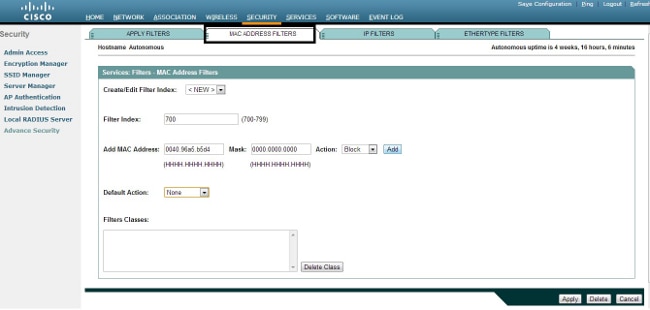
- Click Add in order to add this filter to the Filters Classes. You can also define the default action as Forward All or Deny All.
- Click Apply. ACL 700 is now created.
- In order to apply ACL 700 to a radio interface, navigate to the Apply Filters section. You can now apply this ACL to an incoming or outgoing Radio or GigabitEthernet interface.
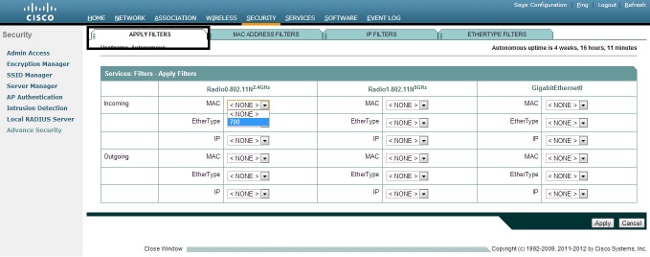
IP Filters
You can use standard or extended ACLs in order to allow or disallow the entry of client devices into the WLAN network based on the IP address of the client.
This configuration example uses extended ACLs. The extended ACL must allow Telnet access to the clients. You must restrict all other protocols on the WLAN network. Also, the clients use DHCP in order to obtain the IP address. You must create an extended ACL that:
- Allows DHCP and Telnet traffic
- Denies all other traffic types
Complete these steps in order to create it:
- Name the filter, and select Block All from the Default Action drop-down list, since the remaining traffic must be blocked:

- Select Telnet from the TCP Port drop-down list, and BOOTP client & BOOTP server from the UDP Port drop-down list:
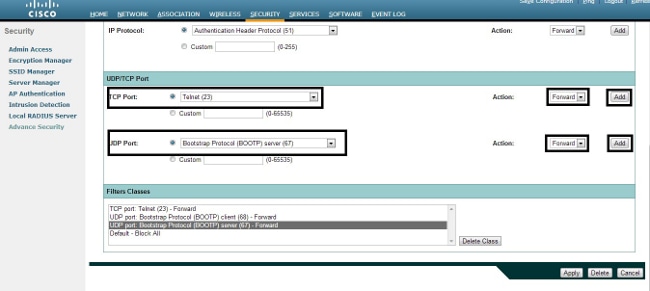
- Click Apply. The IP filter Allow_DHCP?_Telnet is now created, and you can apply this ACL to an incoming or outgoing Radio or GigabitEthernet interface.
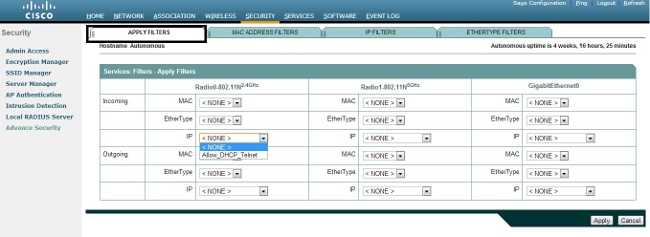
Ethertype Filters
You can use Ethertype filters in order to block Internetwork Packet Exchange (IPX) traffic on the Cisco Aironet AP. A typical situation where this is useful is when IPX server broadcasts choke the wireless link, which sometimes happens on a large enterprise network.
Complete these steps in order to configure and apply a filter that blocks IPX traffic:
- Click the Ethertype Filters tab.
- In the Filter Index field, name the filter with a number from 200 to 299. The number you assign creates an ACL for the filter.
- Enter 8137 in the Add Ethertype field.
- Leave the mask for the Ethertype in the Mask field at the default value.
- Select Block from the action menu, and click Add.
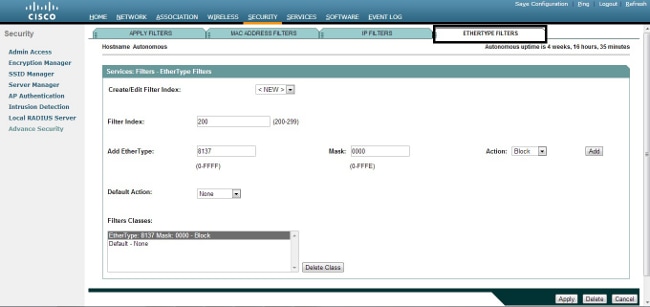
- In order to remove the Ethertype from the Filters Classes list, select it, and click Delete Class. Repeat the previous steps, and add types 8138, 00ff, and 00e0 to the filter. You can now apply this ACL to an incoming or outgoing Radio or GigabitEthernet interface.
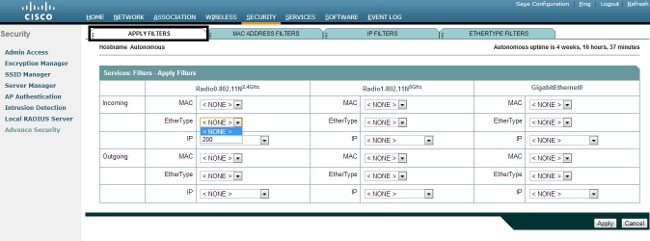
Revision History
| Revision | Publish Date | Comments |
|---|---|---|
1.0 |
15-Oct-2013 |
Initial Release |
Contact Cisco
- Open a Support Case

- (Requires a Cisco Service Contract)







 Feedback
Feedback